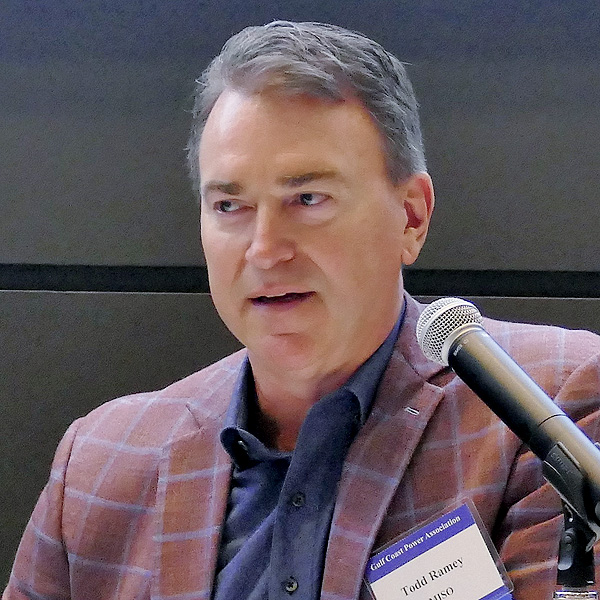VALLEY FORGE, Pa. — PJM’s Operating Committee voted to approve a proposal to allow for cost recovery for facilities determined critical for interconnection reliability operating limits (IROLs) under NERC Critical Infrastructure Protection (CIP) standards.
The PJM-endorsed package received 89% support over the status quo, while an opposing proposal from the Independent Market Monitor received 11%.
PJM’s Darrell Frogg likened the structure to the payments received for providing black start service in that the costs to comply with the requirements can be submitted to both the RTO and Monitor for review and monthly payments would be made through revenue socialized across market participants.
PJM and several stakeholders supporting the proposal argued that having an asset designated as critical infrastructure is beyond the control of an owner, comes with significant financial burden and is unpredictable for market participants because the analysis PJM conducts to identify critical facilities doesn’t look far enough ahead for a generator to include any expenses in future Base Residual Auction (BRA) offers. (See “No Consensus on IROL-CIP Cost Recovery,” PJM OC Briefs: Feb. 9, 2023.)
PJM’s proposal calls for cost recovery to be conducted over 12 months, which supporters pushed for on the basis that CIP status can change annually, creating the prospect that a facility could be designated critical and then have that status reversed shortly after the required upgrades have been completed.
Monitor Joseph Bowring contended that PJM runs markets and is not a cost-of-service regulator, saying there is no justification for having a separate cost-recovery mechanism outside the markets. He also argued that there are substantial differences between IROL-CIP and black start, and that there already are ways for generators to represent the costs of IROL-CIP upgrades in their market offers, which he said is the appropriate place to include costs.
The proposal Bowring presented to the OC would have memorialized that “there is no PJM cost of service recovery mechanism for IROL CIP costs under the PJM governing agreements” and that market participants can instead recover their costs through the existing markets.
Updated Information on Winter Storm Generator Outages
PJM’s Dan Bennett presented more detailed analysis of generator outages during the Dec. 23 winter storm, which shut down more than 23% of capacity in the PJM fleet. (See PJM Gas Generator Failures Eyed in Elliott Storm Review.)
The new data, which was collected from generators reporting to NERC’s Generating Availability Data System (GADS), shows the impact of the total of 2.4 TWh of forced outages over Dec. 23-25. Gas-fired units made up 63% of the unavailable capacity, followed by coal at 28%. All other fuel types represented under 5% of the forced outages during the storm.
The loss of gas supply was the largest reason for gas outages, constituting 31% — or 473,208 MWh — of unavailable capacity, followed by freezing and plant equipment issues. More than half the coal outages were attributed to boiler issues. Across resource types, fuel availability accounted for nearly 500,000 MWh of outages, nearly matched by issues with plant equipment.
Bennett said also that the bulk of unavailable generation did not have a commitment in the day-ahead market, representing 64% of the missing capacity at 7 a.m. on Dec. 24, the peak of the outages. Day-ahead commitment played an even greater role for gas generation, with those lacking a commitment making up 72% of the forced outages; for outages attributed to gas fuel supply issues that figure rose to 89%.
Paul Sotkiewicz, of E-Cubed Policy Associates, said he believes many of the forced outages attributed to gas supply are being misrepresented and that generation may not have been called upon at all and was instead asked to incorrectly take forced outages in some cases. He also questioned how many of the outages could be related to PJM’s forecast, which underestimated temperatures and the amount of generation that would be needed during the storm.
“I’m understanding that there were many resources that were available but were simply not called upon by PJM, and that gets into the question of why that was the case,” he said.
PJM’s Chris Pilong said the data being presented Thursday was based on further analysis of GADS reporting, which would not capture the issues raised by Sotkiewicz, which could be addressed in future presentations to the Market Implementation Committee or in the final report to be released later this year. Sotkiewicz said he believes the OC is the proper forum for that information, which involves how gas nominations are understood operationally.
During an earlier presentation on daily peak forecast error, PJM’s Hong Chen told the OC that demand response load reductions were smaller than the initial estimates, meaning the load forecast error was also lower than originally reported.
Responding to questions about how that is reflected in the data Bennett presented, Pilong clarified that Chen’s presentation was not reflecting that demand response underperformed, but instead that it’s the “measure of expectation.” When calculating the amount of load reduction received by DR, it was not taken into account that some of the load curtailed would already be switched off prior to the DR dispatch. While the amount of load reduced is smaller than expected, the amount of generation offline was the same.
PJM Drafting Comments on Virginia Environmental Rule Change
PJM is planning to submit comments to the Virginia Department of Environmental Quality on a rule change to allow data centers to receive variances expanding the usage of on-site generators when the RTO has declared a maximum generation emergency.
In the announcement of the comment period, which is open through early April, the DEQ said an area in Fairfax, Loudoun and Prince William counties was identified to be at risk of having inadequate transmission capability going into the summer months. The DEQ subsequently revised the proposal to apply only to Loudoun County.
Presenting to the OC, PJM’s Gary Helm said the comments will likely focus on the conditions that would lead PJM to issue a maximum generation alert and how that would interface with the rule change. He noted that PJM recently released a white paper on the balance between resource development, retirements and load growth, which included the accelerating demand from the Data Center Alley centered on Loudoun County. (See “PJM White Paper Expounds Reliability Concerns,” PJM Board Initiates Fast-track Process to Address Reliability.)
Adrien Ford, of the Old Dominion Electric Cooperative (ODEC), recommended that PJM increase its contact with data center developers and operators to get a better understanding of the emergency generators being installed there and the impact that backups of that scale could have on the grid if they go online.
“They’re so big, and some of these are measured in gigawatts not megawatts,” Ford said of the data centers, questioning if the emergency generators would cover a portion or the whole of the data centers’ load.
PJM’s Donnie Bielak said that although PJM does not have dispatch control over the generators, it’s aware of what is being installed and is ready for them in terms of emergency conditions.
Transmission Outage Coordination Proposals Discussed
Stakeholders discussed two proposals being drafted by the Monitor and a joint package from PJM, Public Service Enterprise Group (NYSE:PEG) and DC Energy on coordination between utilities and PJM for extended transmission outages. (See “Outage Coordination Issue Charge Endorsed,” PJM Operating Committee Briefs: May 12, 2022.)
The Monitor’s package would aim to ensure that events like the surge in congestion pricing caused by line work in Virginia’s Northern Neck peninsula are prevented or limited when possible by correctly identifying likely congestion impacts in advance of approving the outages and requesting alternative approaches by relevant transmission owners.
The package would also seek to ensure that outage submission deadlines are enforced prior to FTR auctions and the closing of the day-ahead market. The package would more generally help ensure the provision of more accurate and timely information to all customers about transmission outages, increasing transparency around when they will occur and allowing customers to better plan for them. Bowring said PJM’s current rules need to be strengthened and enforced and must include more clearly defined consequences for utilities that do not provide that information.
The revisions the IMM is proposing in its package include:
- treating a request to reschedule an outage as a new request or as a late submission if they try to reschedule too far out;
- clarifying the definition of the congestion analysis required for outage requests;
- rewriting rules to reduce or eliminate approval of late outage requests after FTR auction bidding opens;
- preventing transmission owners to divide long duration outages into smaller segments to avoid the requirements for longer outages.
In response to the IMM presentation, Exelon’s Sharon Midgley said the outages must be looked at from a reliability lens, not just market impact, adding that they’re necessary for maintenance and implementing capital projects. She said the existing rules are already clear, and levy consequences for being late and have protections to ensure that outages that would cause congestion aren’t approved if they are submitted late. Midgley also noted that much of the IMM proposal is outside the scope of the OC-endorsed stakeholder deliberation as it contains many aspects that conflict with the PJM Consolidated Transmission Owners Agreement (CTOA).
Bowring acknowledged that TO must take outages to support a reliable transmission system but that there are no consequences for not following the existing rules that require clear public notice about those outages, and that the rules are frequently not followed as documented in the Market Monitor’s presentation to the OC.
The joint proposal would expand the transmission outage information shared by PJM, expand the switching solutions information PJM provides and change the Regional Transmission Expansion Plan (RTEP) outage coordination process to have PJM staff review approved RTEP projects to identify those that may require extended outages and to then coordinate with TOs to assess the need for those outages and their impacts.



